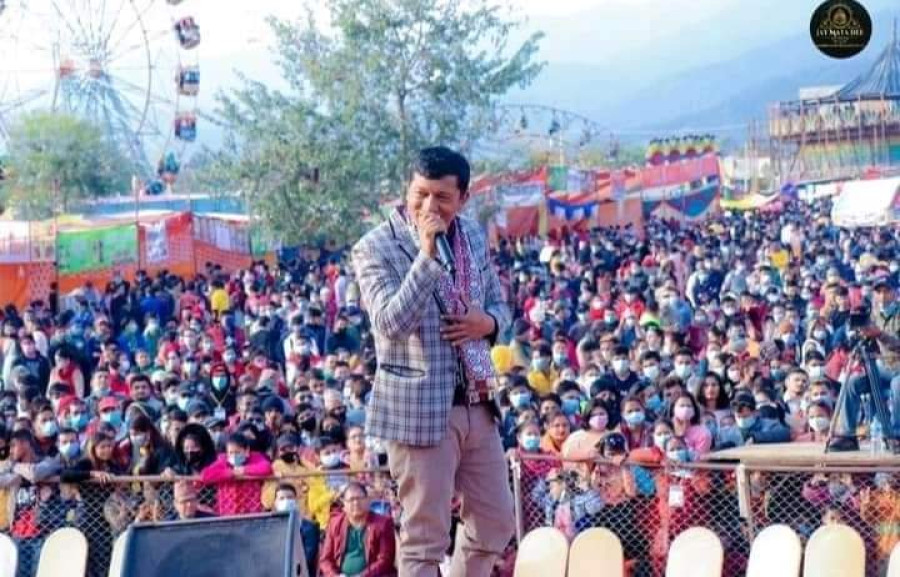Culture & Lifestyle
Teej songs veer off traditional cultural norms
Various artists from Lumbini Province shed light on the evolution of Nepali folk music—particularly Teej songs—and the challenges they navigate to maintain the authenticity of the genre.
Sanju Paudel
Dipu Magar, a native of Nau Bahini Rural Municipality Ward 8, developed an early liking for folk music that began during his school days. He actively participated in school-level and, later, local-level dohori (a type of Nepali folk song, usually sung in duets) competitions. This, alongside singing at events regularly, helped him develop himself as an artist and spread his name.
Over the years, Magar, who is the current president of the Lumbini Folk and Duet Song Academy (Lumbini Lok Tatha Dohori Geet Pratisthan), has achieved significant milestones. However, most people know him for his Teej songs. To date, he has released about fifteen Teej songs.
Magar’s musical journey took flight when he moved to Butwal, where he reveals he was lucky enough to be surrounded by supportive friends. He debuted in 2010 with an album, but it was in 2013 that his efforts began to pay off as his song ‘Sarara Saari Sarkaera’ became a hit. His 2017 track ‘Chhuk Chhuke Rail’ also garnered widespread acclaim.
About his musical influences, Magar says, “I draw inspiration from seasoned artists and strive to incorporate their influences into his singing style.” He emphasises the importance of lyrics and the messages conveyed in songs. He helped the National Folk and Duet Song Academy establish a committee to maintain the authenticity of folk songs. This is a cause close to Magar’s heart as he believes understanding the style in which an artist presents their art is crucial.
In the realm of traditional Teej songs, Magar aims to modernise the lyrics and melodies while preserving the core essence of this tradition. He believes that each song carries distinct emotions and that artists must connect with their audience by aptly portraying the sentiments behind the lyrics they sing.
He explains, “Adapting songs to the time’s needs represents a natural evolution in music. This way, even young people can still appreciate traditional songs in contemporary variations.”
Another prominent figure in the world of Teej tracks is Silu Bhattarai from Gulmi. With more than 100 songs to her name, she has earned nationwide recognition for her distinct voice. Every Teej season, her songs can be heard from microbuses to the Teej events, a testament to her popularity.
“My affinity for Teej songs stems from childhood memories of listening to them with my mother,” reminisces the singer, adding, “I sing to keep that memory alive.”
Before her singing career, she worked as a beautician and dreamt of becoming a model. However, during a visit to Kathmandu, her companions encouraged her to sing, marking the beginning of her musical journey. Her first Teej song, ‘Ghum Pakum Ghum,’ released in 2014, garnered considerable attention, motivating her to continue releasing such tracks. She believes her uniqueness lies in preserving the genre's authenticity, even as she experiments with other styles.
She expresses, “I receive offers to sing all kinds of (teej) songs, but I only accept those that authentically fit the genre.”
Bhattarai has performed at various Teej events in India and Qatar in the past and plans to visit Dubai for this year’s celebrations. Among her releases, ‘Bhageri Charile’ and ‘Bhuipatra Hallaudai’ stand out as ones that are played the most during Teej. she reveals that currently, her focus is on making songs suitable for all age groups, prioritising substance over glamour.
In 2003, Sita Rana Magar from Gulmi moved to Butwal to kick-start her career in music. She released her first song the next year. Although she began with dohoris, she has since explored other genres too. Her career began when songs were primarily enjoyed on CDs and VCDs, but she acknowledges that modernisation has allowed artists to connect with audiences through radio and online platforms.
Rana Magar currently serves as the secretary of the District Committee of Folk and Duet Song Academy in Gulmi. She is known for songs like ‘Noutunako Rail’ and ‘Sorry La’.
This year, however, Rana Magar will not release Teej tracks and instead focuses on making music fit for other festivals. She emphasises the importance of respecting cultural musical practices while adapting to modern platforms and styles.
Before Prachanda GC journeyed into folk music, he used to perform live dohori, but that was until 2004 when he hadn’t migrated to Butwal. He is concerned about the state of folk music right now, noting the shift towards pursuing money and online views. Many artists prioritise popularity and revenue over authentic and meaningful music, he observes. While a few artists do strive to preserve the genre’s authenticity, they often go unrecognised by the government and music organisations.
“Listeners and viewers tend to click on videos with the highest online views, showing less appreciation for songs that safeguard the genre’s heritage,” he adds. According to GC, this year’s Teej songs have missed the mark both in terms of quality and quantity, reflecting changing audience preferences.




 11.12°C Kathmandu
11.12°C Kathmandu













%20(1).jpg&w=300&height=200)

